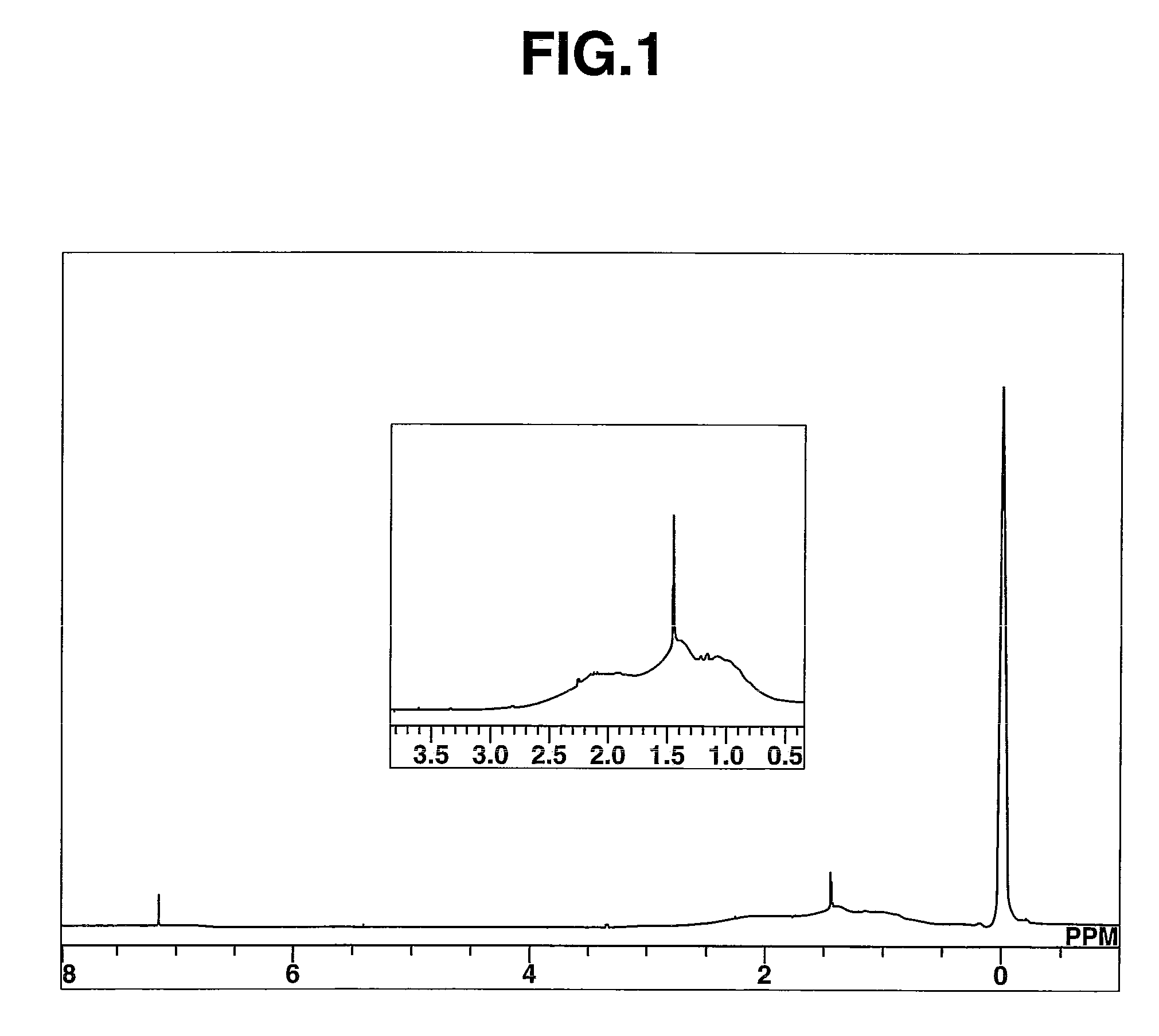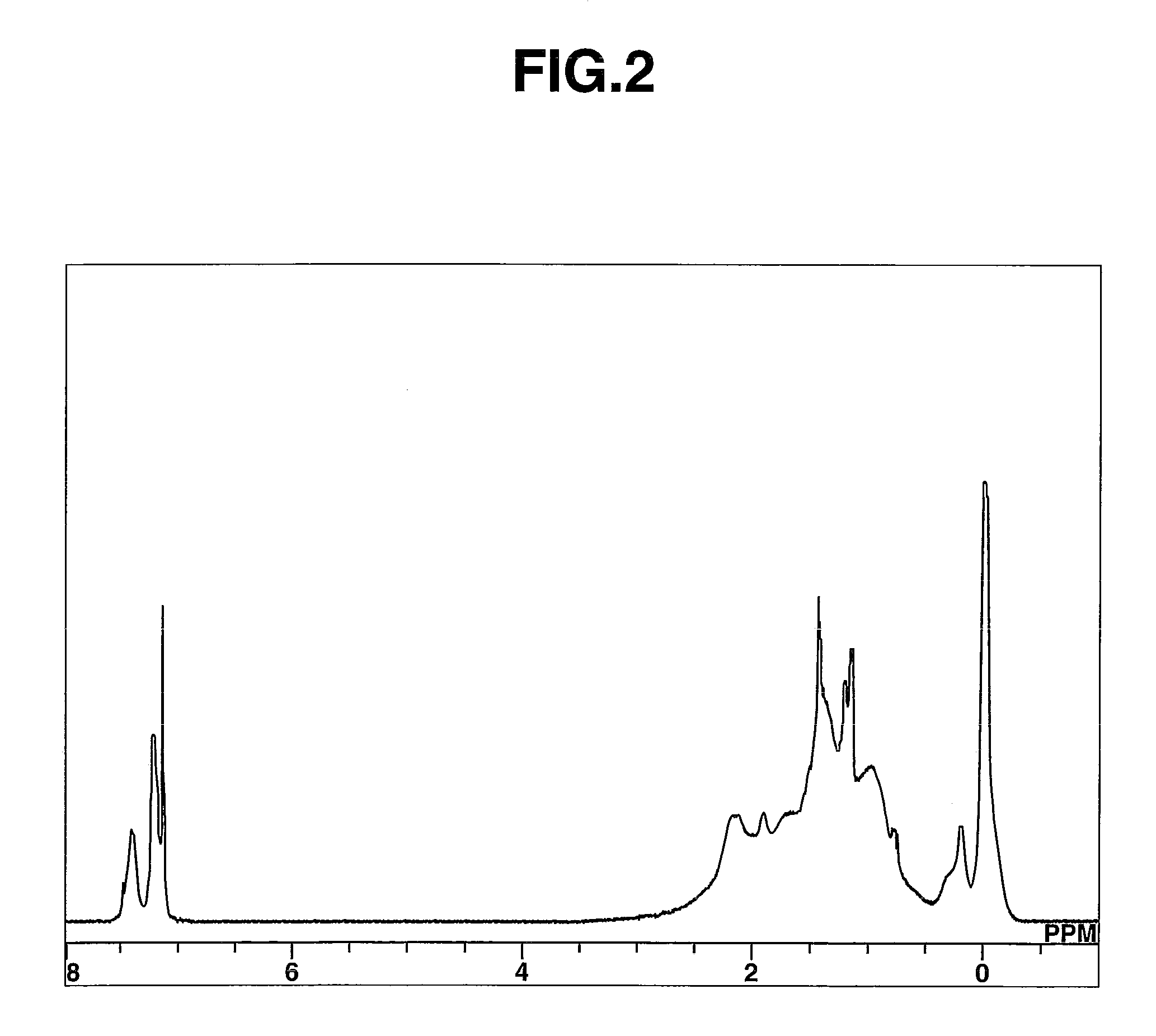Cycloolefin addition polymer and making method
a technology of cycloolefin and polymer, applied in the field of cycloolefin addition polymers, can solve the problems of reducing work efficiency, affecting the efficiency of work, and reducing the oxygen content of space, and achieves good gas permeability and high thermal stability. or heat resistance.
- Summary
- Abstract
- Description
- Claims
- Application Information
AI Technical Summary
Benefits of technology
Problems solved by technology
Method used
Image
Examples
example 1
[0100]A nitrogen-purged glass reactor was charged with 30.0 g (0.077 mol) of Monomer A having formula (7), 9.4 g (0.100 mol) of Monomer B (norbornene) having formula (8), and 37 mg (40 μmol) of trityltetra(pentafluorophenyl)borate ([Ph3C][B(C6F5)4]), which were dissolved in 140 ml of toluene. A catalyst solution which was separately prepared by dissolving 9 mg (40 μmol) of cyclopentadienyl(allyl)palladium (C5H5PdC3H5) and 12 mg (40 μmol) of tricyclohexylphosphine (PCy3) in 15 ml of toluene was added to the reactor where polymerization reaction took place at room temperature (25° C.) for 3 hours.
[0101]After the completion of reaction, the reaction solution was poured to a large volume of methanol for precipitation. This was followed by filtration, washing and vacuum drying at 60° C. for 5 hours, obtaining 28.5 g (yield 72%) of Polymer P-1.
[0102]Polymer P-1 had Mn=778,100 and Mw / Mn=1.53 as measured by GPC. On 1H-NMR analysis as shown in FIG. 1, the polymer was found to contain structu...
example 2
[0103]A nitrogen-purged glass reactor was charged with 44.8 g (0.115 mol) of Monomer A having formula (7), 5.8 g (0.062 mol) of Monomer B (norbornene) having formula (8), and 37 mg (40 μmol) of trityltetra(pentafluorophenyl)borate ([Ph3C][B(C6F5)4]), which were dissolved in 140 ml of toluene. A catalyst solution which was separately prepared by dissolving 9 mg (40 μmol) of cyclopentadienyl(allyl)palladium (C5H5PdC3H5) and 12 mg (40 μmol) of tricyclohexylphosphine (PCy3) in 15 ml of toluene was added to the reactor where polymerization reaction took place at room temperature (25° C.) for 5 hours.
[0104]After the completion of reaction, the reaction solution was poured to a large volume of methanol for precipitation. This was followed by filtration, washing and vacuum drying at 60° C. for 5 hours, obtaining 31.8 g (yield 63%) of Polymer P-2.
[0105]Polymer P-2 had Mn=601,300 and Mw / Mn=1.49 as measured by GPC. On 1H-NMR analysis as shown in FIG. 2, the polymer was found to contain structu...
example 3
[0106]The procedure of Example 1 was repeated aside from using 30.2 g (0.100 mol) of Monomer C having formula (9) instead of Monomer A. There was obtained 24.0 g (yield 61%) of Polymer P-3.
[0107]Polymer P-3 had Mn=735,800 and Mw / Mn=1.24 as measured by GPC. The polymer was found to contain structural units derived from Monomer C and structural units derived from Monomer B in a compositional ratio C / B=50 / 50 (mol / mol). Polymer P-3 was dissolved in toluene to form a 10% by weight polymer solution. Using the solution casting method, the polymer solution was cast and dried at 60° C. for 24 hours to form a polymer film F-3.
PUM
| Property | Measurement | Unit |
|---|---|---|
| mol % | aaaaa | aaaaa |
| mol % | aaaaa | aaaaa |
| polydispersity index | aaaaa | aaaaa |
Abstract
Description
Claims
Application Information
 Login to View More
Login to View More - R&D
- Intellectual Property
- Life Sciences
- Materials
- Tech Scout
- Unparalleled Data Quality
- Higher Quality Content
- 60% Fewer Hallucinations
Browse by: Latest US Patents, China's latest patents, Technical Efficacy Thesaurus, Application Domain, Technology Topic, Popular Technical Reports.
© 2025 PatSnap. All rights reserved.Legal|Privacy policy|Modern Slavery Act Transparency Statement|Sitemap|About US| Contact US: help@patsnap.com



